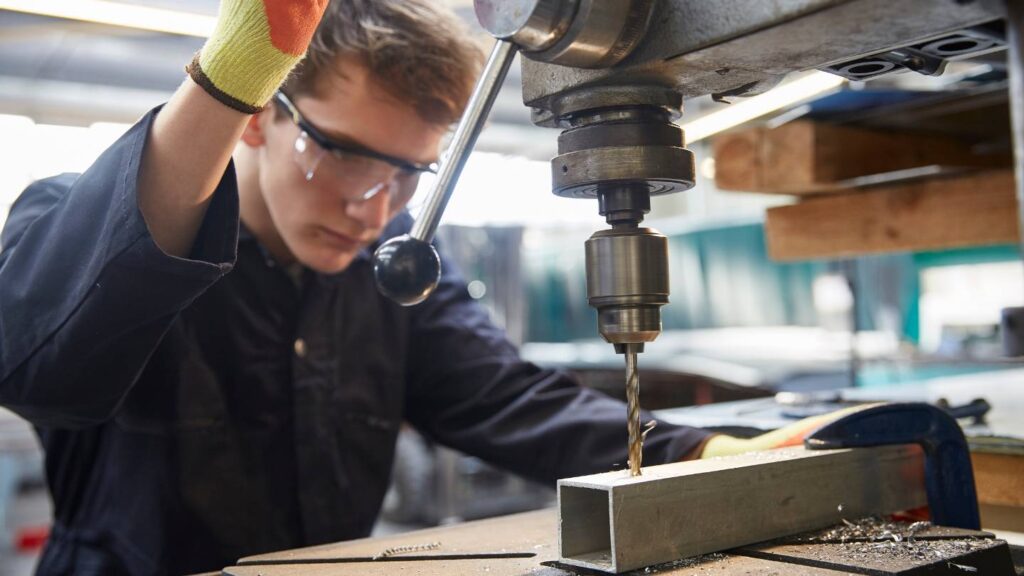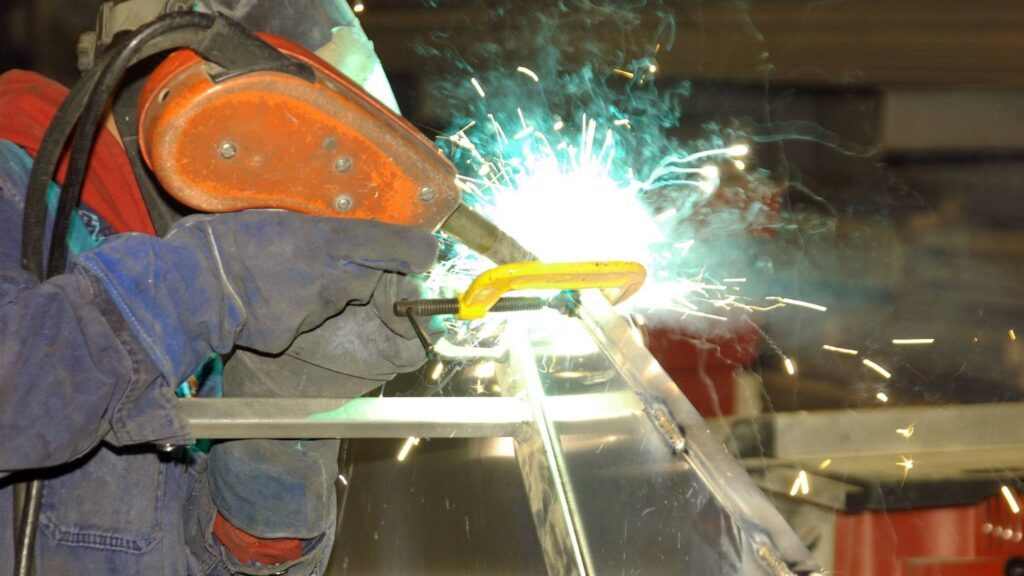Aluminium fabrication is a fundamental process in various industries, where raw aluminium is transformed into functional products through a series of methods.
This process is essential for producing a wide range of items, from simple parts to complex structures. The techniques involved in aluminium fabrication, as well as its benefits and applications, is crucial for anyone involved in manufacturing or engineering.
Let’s get straight to the point
Aluminium fabrication is a key process in manufacturing, involving the transformation of raw aluminium into functional products through techniques like cutting, bending, welding, machining, and finishing.
This process is essential for producing a wide range of items across various industries, such as aerospace, automotive, construction, and medical sectors. Aluminium is favored for its lightweight, corrosion resistance, versatility, recyclability, and heat resistance.
When selecting a fabricator, factors like experience, technology, design involvement, and cost are crucial. Aluminium’s sustainability benefits make it an ideal material for modern manufacturing.

What is Aluminium Fabrication?
Aluminium fabrication involves converting raw aluminium into finished products by employing several techniques. These techniques include cutting, bending, welding, machining, and finishing. Each step plays a vital role in shaping the final product, ensuring it meets specific requirements for functionality and durability.
Key Techniques in Aluminium Fabrication
Cutting Techniques in Aluminium Fabrication
Cutting is the initial stage in aluminium fabrication, where the raw material is sliced into desired shapes and sizes. This can be done using various tools, including:
- Saws: Utilised for making straight cuts, especially on thicker aluminium sheets.
- Laser Cutters: Ideal for achieving precision in complex designs.
- CNC Machines: Automated cutting that provides high accuracy, making it suitable for large-scale production.
Choosing the appropriate cutting tool depends on factors such as material thickness and the complexity of the design.
Bending and Forming Aluminium
After cutting, the aluminium is bent or formed into the required shapes. This process can be done using several methods:
- Press Braking: Commonly used to bend aluminium sheets into angles or curves.
- Rolling: Used for creating cylindrical shapes or large curves.
- Stamping: Involves pressing the aluminium into a mould to achieve a specific shape.
These methods are essential for producing components with specific angles, curves, or intricate designs.
Welding Techniques for Aluminium
Welding is a process where multiple pieces of aluminium are joined together to form a single structure. The most common welding techniques include:
- TIG Welding (Tungsten Inert Gas): Provides strong, precise welds, suitable for thinner materials.
- MIG Welding (Metal Inert Gas): Faster than TIG welding, ideal for thicker materials and larger projects.
Welding requires precise control to avoid issues such as warping or cracking, ensuring a durable and robust final product.
Machining Aluminium
Machining involves shaping aluminium by removing excess material through various processes:
- Turning: The aluminium is rotated while a cutting tool shapes it.
- Milling: A rotating tool moves across the aluminium, removing material to create precise shapes.
- Drilling: Used to make holes accurately.
Machining is essential for producing components with intricate designs and tight tolerances, especially in industries like aerospace and automotive.
Finishing Aluminium Products
Finishing is the final step in aluminium fabrication, enhancing both the appearance and functionality of the product. Common finishing techniques include:
- Polishing: Creates a smooth, reflective surface.
- Anodising: Adds a protective layer, improving corrosion resistance.
- Powder Coating: Applies a durable, coloured finish that protects the aluminium from environmental factors.
Finishing ensures the aluminium product is not only functional but also aesthetically pleasing and resistant to wear and tear.
Types of Aluminium Used in Fabrication
Common Forms of Aluminium in Fabrication
Aluminium is available in various forms, each suitable for different fabrication methods. The most commonly used types include:
- Aluminium Sheets: Thin, flat pieces used in applications such as roofing, cladding, and vehicle panels.
- Aluminium Extrusions: Long sections with consistent cross-sections, used in frames, supports, and channels.
- Aluminium Castings: Shapes formed by pouring molten aluminium into moulds, often used in complex parts like engine components.
- Aluminium Rods and Bars: Solid pieces used in structural applications and machining.
Each type of aluminium offers unique properties that make it suitable for specific fabrication processes and end-use applications.
Advantages of Aluminium in Fabrication
Lightweight Properties of Aluminium
Aluminium’s low density makes it an excellent choice for applications where weight is a critical factor. This is particularly important in industries such as aerospace and automotive, where reducing weight can lead to improved fuel efficiency and performance.
Corrosion Resistance in Aluminium Products
Aluminium naturally forms a protective oxide layer, which makes it highly resistant to corrosion. This property is especially valuable in environments exposed to moisture or harsh weather conditions, ensuring the longevity of aluminium products.
Versatility in Aluminium Fabrication
Aluminium can be easily shaped, welded, and machined, allowing for the creation of a wide range of products with varying complexities. Whether used for simple components or intricate designs, aluminium’s versatility makes it suitable for numerous applications.
Aluminium’s Recyclability and Environmental Impact
Aluminium is one of the most recyclable materials, retaining its properties even after multiple recycling processes. This recyclability reduces waste and energy consumption, making aluminium a sustainable choice in modern manufacturing.
Heat Resistance of Aluminium in Various Applications
Aluminium maintains its strength even at high temperatures, making it suitable for applications in industries such as construction and petrochemicals. Its heat resistance ensures that aluminium components perform reliably under extreme conditions.
Applications of Aluminium Fabrication
Aerospace Industry Applications
In the aerospace sector, aluminium is widely used due to its strength-to-weight ratio. It is commonly found in aircraft structures such as fuselages, wings, and engine components, where minimising weight without compromising strength is essential.
Automotive Industry Uses for Aluminium
The automotive industry relies heavily on aluminium for producing parts like car bodies, engine blocks, and heat exchangers. Aluminium’s lightweight nature helps improve fuel efficiency and overall vehicle performance, making it a valuable material in car manufacturing.
Construction Industry Applications
In the construction industry, aluminium is used for building materials such as roofing, cladding, window frames, and structural supports. Its durability, combined with ease of installation, makes it a popular choice for both residential and commercial buildings.
Medical Industry Utilisation of Aluminium
Aluminium’s non-toxic and corrosion-resistant properties make it ideal for medical applications. It is used in manufacturing equipment such as surgical instruments, hospital furniture, and ventilators, where hygiene and durability are critical.

Choosing the Right Aluminium Fabricator
Importance of Experience in Aluminium Fabrication
The experience of a fabricator is a strong indicator of their ability to deliver high-quality results. Companies with extensive experience in aluminium fabrication are more likely to understand the challenges involved and how to overcome them.
Role of Technology in Aluminium Fabrication
Modern technology plays a crucial role in aluminium fabrication. Advanced machinery, such as CNC machines and laser cutters, ensures precision, efficiency, and consistency in the final product.
Design Involvement in Aluminium Fabrication Projects
Involving the fabricator early in the design process can lead to better outcomes. Fabricators who understand the design process can provide valuable input that enhances the manufacturability and performance of the product.
Time Management for Aluminium Fabrication Projects
Meeting project timelines is essential in any fabrication process. It is important to ensure that the fabricator can meet deadlines without compromising the quality of the work. Establishing realistic deadlines from the beginning helps avoid rushed work, which can lead to subpar results.
Cost Considerations in Aluminium Fabrication
While cost is always a factor, it is important to consider the overall value rather than just the price. A slightly higher quote may reflect a commitment to using state-of-the-art technology or delivering superior quality, which can be worth the investment in the long run.
Aluminium’s Role in Sustainable Manufacturing
Recycling Benefits of Aluminium
Aluminium can be recycled multiple times without losing its quality, reducing the need for raw materials and lowering environmental impact. The recycling process for aluminium also requires significantly less energy compared to producing new aluminium from ore.
Energy Efficiency in Aluminium Production
Producing recycled aluminium is much more energy-efficient than producing new aluminium. This efficiency contributes to overall energy savings in the manufacturing process, making aluminium a more sustainable option.
Durability and Longevity of Aluminium Products
Aluminium’s resistance to corrosion and wear extends the lifespan of products, reducing the frequency of replacements and minimising waste. This durability makes aluminium a valuable material for sustainable manufacturing practices.
Conclusion
Aluminium fabrication is a critical process in modern manufacturing, offering numerous benefits such as lightweight, durability, versatility, and sustainability. Through techniques like cutting, bending, welding, and finishing, aluminium is transformed into a wide range of products used across various industries.
When selecting an aluminium fabricator, it is important to consider factors such as experience, technology, design involvement, time management, and cost. These factors ensure you choose the right partner for your project. As sustainability becomes more critical in manufacturing, aluminium’s recyclability and energy efficiency position it as an ideal material for the future.
Understanding the intricacies of aluminium fabrication and the advantages it offers allows businesses to create high-quality, cost-effective solutions that meet the demands of a diverse range of industries.

